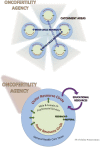Oncofertility in Canada: an overview of Canadian practice and suggested action plan
- PMID: 24155643
- PMCID: PMC3805415
- DOI: 10.3747/co.20.1361
Oncofertility in Canada: an overview of Canadian practice and suggested action plan
Abstract
Background: Cancer can be a devastating diagnosis. In particular, malignancy and its indicated treatments have profoundly negative effects on the fertility of young cancer patients. Oncofertility has emerged as a new interdisciplinary field to address the issue of gonadotoxicity associated with cancer therapies and to facilitate fertility preservation. In Canada, these fertility issues are often inadequately addressed despite the availability of resources. The goal of this four-part series is to facilitate systemic improvements in fertility preservation for adolescent and young adult Canadians with a new diagnosis of cancer.
Methods: Here, we describe the services currently available in Canada and the challenges associated with their utilization. Finally, we outline strategies to help maximize and facilitate fertility preservation in the young cancer patient.
Results: Despite an existing infrastructure to the oncofertility system in Canada, the ability of that system's components to function together and to coordinate patient care is a challenge. Areas of weakness include poor access and referral to fertility services, a lack of readily available education for patients and health care providers, and inconsistent interdisciplinary coordination in patient care.
Conclusions: The implementation of a framework for multidisciplinary resource allocation, education, patient referral, and established lines of communication may facilitate a functional oncofertility system in Canada.
Keywords: Oncofertility; adolescent; cryopreservation; fertility preservation; gonadotoxicity; young adult.
Figures
Similar articles
-
Barriers to Oncofertility Care among Female Adolescent Cancer Patients in Canada.Curr Oncol. 2022 Mar 3;29(3):1583-1593. doi: 10.3390/curroncol29030133. Curr Oncol. 2022. PMID: 35323333 Free PMC article. Review.
-
Oncofertility in Canada: gonadal protection and fertility-sparing strategies.Curr Oncol. 2013 Dec;20(6):e602-7. doi: 10.3747/co.20.1359. Curr Oncol. 2013. PMID: 24311962 Free PMC article.
-
Oncofertility in Canada: the impact of cancer on fertility.Curr Oncol. 2013 Aug;20(4):e338-44. doi: 10.3747/co.20.1358. Curr Oncol. 2013. PMID: 23904772 Free PMC article.
-
Oncofertility in Canada: cryopreservation and alternative options for future parenthood.Curr Oncol. 2014 Feb;21(1):e137-46. doi: 10.3747/co.20.1360. Curr Oncol. 2014. PMID: 24523611 Free PMC article.
-
Anticancer treatments and female fertility: clinical concerns and role of oncologists in oncofertility practice.Expert Rev Anticancer Ther. 2017 Aug;17(8):687-692. doi: 10.1080/14737140.2017.1335199. Epub 2017 Jun 5. Expert Rev Anticancer Ther. 2017. PMID: 28537815 Free PMC article. Review.
Cited by
-
Barriers to Oncofertility Care among Female Adolescent Cancer Patients in Canada.Curr Oncol. 2022 Mar 3;29(3):1583-1593. doi: 10.3390/curroncol29030133. Curr Oncol. 2022. PMID: 35323333 Free PMC article. Review.
-
Gaps in Adolescent and Young Adult Cancer Education in Oncology Fellowship Training.J Adolesc Young Adult Oncol. 2024 Feb;13(1):97-104. doi: 10.1089/jayao.2023.0056. Epub 2023 Jul 21. J Adolesc Young Adult Oncol. 2024. PMID: 37477884 Free PMC article.
-
Patterns of Referral for Fertility Preservation Among Female Adolescents and Young Adults with Breast Cancer: A Population-Based Study.J Adolesc Young Adult Oncol. 2019 Apr;8(2):197-204. doi: 10.1089/jayao.2018.0102. Epub 2019 Jan 24. J Adolesc Young Adult Oncol. 2019. PMID: 30676852 Free PMC article.
-
Oncofertility Decision Support Resources for Women of Reproductive Age: Systematic Review.JMIR Cancer. 2019 Jun 6;5(1):e12593. doi: 10.2196/12593. JMIR Cancer. 2019. PMID: 31199289 Free PMC article.
-
Fertility preservation in reproductive-age women facing gonadotoxic treatments.Curr Oncol. 2015 Aug;22(4):e294-304. doi: 10.3747/co.22.2334. Curr Oncol. 2015. PMID: 26300680 Free PMC article.
References
-
- Yee S, Buckett W, Campbell S, Yanofsky R, Barr RD. A national study of the provision of oncofertility services to female patients in Canada. J Obstet Gynaecol Can. 2012;34:849–58. - PubMed
LinkOut - more resources
Full Text Sources
Other Literature Sources


